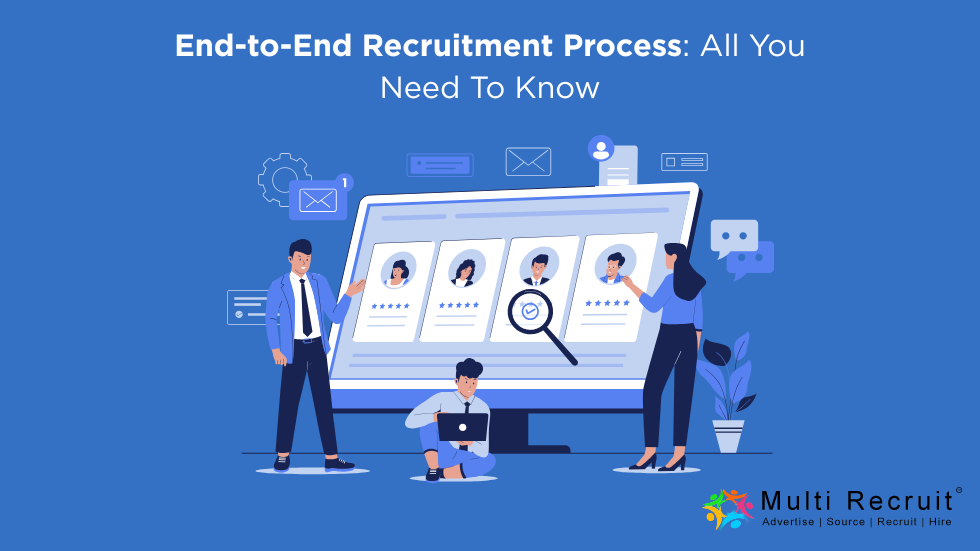The recruitment landscape of 2025 is a rapidly changing one, shaped by digital transformation, hybrid working, and increased competition for the best talent. “End-to-end recruitment process” has become a significant or prominent framework for any organization seeking to create more agile, high-performing teams. This all-encompassing process ranges from determining recruiting needs to the successful onboarding of new team members after joining our company, aligned with business goals. For HR practitioners, this is key to diminishing time-to-hire and ensuring good candidate experience and diversity. This post examines the crucial steps, difficulties, and tactics for end-to-end recruitment in your company.
Why the E2E Hiring Journey Matters in 2025?
End-to-end recruitment is more than just a to-do list—it’s the strategic plan for efficiently attracting top talent. With talent shortages in every corner of the world, and well over 70% of employees projected to be working remotely at least part-time by 2025, elegance is no longer only a nice-to-have for hiring. Organizations with effective processes have up to 30% less turnover and are filling job seats the jobs 25% faster. Getting recruitment wrong is not an option, considering that empty positions cost companies anywhere from 50-200% of an employee’s yearly wage in terms of fees.
The era of AI and automation has transformed hiring, allowing for data-based decision-making while also requiring upskilling to avoid bias. The variability of candidates, with new player expectations, ranging between flexibility and DEI commitment, makes hiring harder. It relies on a sound end-to-end process to enforce consistency, compliance, and quality, putting organizations in the frame for success in an increasingly competitive market.
Key Stages in the End-to-End Recruitment Process
There are stages of recruitment end-to-end, which are mutually exclusive but indispensable. Here are the core parts for 2025:
Workforce Planning and Job Analysis
Identifying hiring requirements by working with departmental heads as the recruitment process commences. Examine skill shortages, business priorities, and future needs. Create elaborate job descriptions (JD) that list roles, skills, and company culture. In 2025, 65% of applicants value clear JDs with flexible work options, but vague roles result in 20% higher rejection.
Sourcing and Attraction
Good sourcing will focus on both active and passive candidates – you can typically find the former on job boards, social media pages or through a referral. AI tools increase accuracy, but 80% of the top talent is passive and needs to be reached out to specifically. Diversity sourcing is key — 75% of job hunters appreciate DEI-focused employers, but only 30% of companies make efforts to actively diversify talent pools.
Screening and Shortlisting
It filters applications by keywords and qualifications with Applicant Tracking Systems (ATS). Manual reviews determine fit, with structured scorecards to avoid bias. In high-volume situations, not-so-great applications are taking over and overwhelming… resulting in hiring delays of 15-20 days on average.
Interviewing and Assessment
Interviews are hybrid technical, behavioral, and cultural assessments. Virtual platforms take precedent; however, 60% of employers find it challenging to evaluate remote fit. Well-designed experience with standardized formats promotes fairness, but 40% of candidates say they’ve had a bad interview experience due to a lack of feedback.
Selection and Offer Management
After the interview, reference checks, and analytics-based decisions seal the selections. Competitive offers to strike a balance of salary and perks are vital, as 50% of candidates decline a job offer because it took too long. GDPR and other regulations are not optional.
Onboarding and Integration
Onboarding creates retention momentum. Formal 30-60-90 day plans, mentorship, and tech access increase engagement. Businesses that excel at onboarding have 82% higher employee retention, but a quarter of recruits leave within six months because of poor integration.
Comparative Analysis: Challenges Across Organization Sizes
| Challenge | Small Businesses | Large Enterprises | Solutions Focus |
|---|---|---|---|
| Resource Constraints | High | Low | Automation |
| Talent Attraction | Medium | High | Employer Branding |
| Process Efficiency | High | Medium | AI and ATS Integration |
| DEI Implementation | Medium | High | Bias-Detection Tools |
| Onboarding Effectiveness | High | Medium | Structured Programs |
Small businesses have resource constraints, and enterprises value both scaling and compliance.
Emerging Trends in End-to-End Recruitment for 2025
AI-based hiring is a hot trend automating assessments & reducing time-to-fill by 40%. Core skills are the new “blockbuster” job launchers, with 60% of employers hiring for skills over academic credentials to overcome potential skill gaps. Hybrid work requires virtual interview tools and flexible policies. Tools and analytics that address DEI are important, especially since 76% of candidates prefer inclusive companies. Ongoing talent pipeline for future demands.
Strategies to Optimize the End-to-End Recruitment Process
Utilize AI and Automation: Employ ATS &AI chatbots to automate the screening process, reducing manual effort by 50%.
- Developer Relations and enhance employer branding: You will develop winning messaging around flexibility and DEI to attract top talent, and increase application rates by 30%.
- Enhance the Candidate Experience — Make the application process easier and provide feedback promptly; 70% of candidates appreciate honesty!
- Foster DEI: Use bias-detection software and diverse sourcing to achieve inclusivity outcomes.
- Reinforce Onboarding: With structured programs and mentorship, increase retention by 25%.
How Can We Improve Your Hiring Process?
Our AI-driven platform accelerates sourcing and screening up to 35% faster. Customized plans promote diversity and a better candidate experience, while strong onboarding improves retention over time. We provide scalable solutions with guaranteed return on investment for any size of business.
Conclusion: Building a Future-Ready Workforce
A streamlined, end-to-end recruiting process in 2025 connects increasingly scarce talent with a hybrid approach to work and growing DEI expectations. With the adoption of AI, skills-based recruiting, and candidate-first practices, companies can hire the best talent with precision at scale. We are invested in re-imagining your hiring experience throughout Multi Recruit. Collaborate with Multi Recruit to enhance your recruitment strategy and create a strong workforce now.

